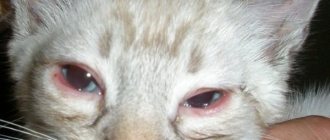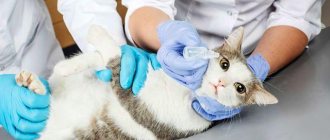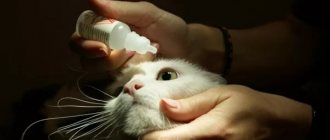Here are some common causes of cat eye discharge:
Feline upper respiratory tract infections
A common cause of discharge is feline calicivirus, infectious respiratory disease, pneumonitis or rhinotracheitis (herpes virus), bacteria and protozoa.
Symptoms can be mild or progress to very severe and may include a sticky, purulent discharge.
Conjunctivitis (pink eye)
Inflammation of the light pink lining around your cat's eye, conjunctivitis can cause one or both of your cat's eyes to become red and swollen, become light-sensitive, and have clear, watery, or thick mucus discharge from the eyes.
Conjunctivitis with fever, diarrhea and difficulty breathing may indicate potentially fatal feline infectious peritonitis, although this is not very common.
Corneal diseases
A cat's cornea, the dome-shaped surface covering the front of the eye, can become inflamed, injured, or ulcerated. The result may be cloudiness, excessive blinking, inflammation, and increased tear production.
Watery eyes (epiphora)
Blocked tear ducts, excessive tear production, allergies, viral conjunctivitis, and more can be the cause of your cat's abnormal tearing.
Uveitis
Inflammation of the internal structures of the eye, injury, cancer, immune problems, or infections can cause severe, often painful uveitis.
Dry eye (keratoconjunctivitis sicca)
Chronic lack of tear production and dryness can lead to inflammation of the cornea, red eyes and, if left untreated, blindness. The absence of the watery part of tears can lead to yellow, sticky discharge from the eyes.
Other causes of discharge include allergies, something stuck in the eye, or problems with the third eyelid.
Prevention of eye diseases in cats
Prevention of eye diseases consists of the following actions:
- do not smoke in the room where the pet lives, avoid using perfumes and household chemicals;
- use hypoallergenic ready-made comas of at least premium class;
- destroy ectoparasites and conduct quarterly deworming;
- Vaccinate your pet regularly according to the vaccination plan.
- cats predisposed to eye diseases are periodically instilled with prophylactic agents.
Be sure to read:
The cat has a stuffy nose: reasons, how to treat it, is it possible to use nasal drops, what will happen if the runny nose is not treated
Eye diseases or digestive disorders are caused by human food, so giving your pet a treat can result in illness.
When to contact a veterinarian
Your cat's eyes are as gentle as they are beautiful. Small problems can quickly develop into serious ones. If your cat's eye discharge symptoms do not go away within 24 hours or if your cat squints, contact your veterinarian immediately.
If you have any medications left over from a previous eye problem, do not use them on your cat's eyes.
Different eye problems require different medications, and you may end up causing serious injury by taking the wrong medication.
Symptoms
Often, pathological discharge from the eye is brown. This shows that the secretion has a purulent composition. The cause is a bacterial infection. Additionally, the sick animal experiences lethargy, rhinitis, and a runny nose. Eyes can fester due to a malfunction of the tear ducts.
Abundant and thick transparent secretion is an indicator of a viral infection. If the consistency is noted as watery, then most likely it is an allergy. A typical symptom is swelling of the eyes. A large number of tears flow out, but without pus. There are reddish stains, which are extremely difficult to notice. In this case, the cause is an injury or scratch.
Home Care: Tips to Keep Your Cat's Eyes Healthy
You can help avoid eye problems in your cat by upgrading to annual vaccinations, avoiding kitten overcrowding, and checking your cat's eyes frequently for redness, cloudiness, changes in color or shape, discharge, or sensitivity to light.
To safely remove your cat's secretions and make them more comfortable while waiting for a visit to the vet, arm yourself with a pack of cotton balls and these simple tips from the ASPCA:
- Dip a cotton pad into water. Wipe the discharge from the eye, always with the edge of the eye facing outwards. Use a fresh cotton pad for each eye.
- Stay away from any over-the-counter drops or detergents unless prescribed by your veterinarian.
Because proper treatment can be critical to your cat's health and well-being, always consult with your veterinarian to ensure your kitten is receiving the right care.
What can I do and how can I help the kitten?
First you need to understand the nature of the discharge. If these are tears, the discharge is clear and watery, and when it dries, it forms accumulations in the corners of the eyes, then the only thing the kitten needs at the moment is good hygiene. To do this, it is enough to regularly wipe your eyes and instill drops, which can be bought at any veterinary pharmacy.
If even after this the eyes continue to water, and the discharge is purulent and stringy, then you should contact a veterinary clinic.
Only an experienced veterinarian can determine what caused increased lacrimation and whether this is the norm for a particular young age, or whether it is a symptom of a serious disease. Accordingly, only a veterinarian can select treatment.
POLAR BEAR
The veterinary clinic in Nizhny Novgorod "White Bear" provides all types of services for cats and dogs.
Conducts any examinations and tests in its own veterinary laboratory; the clinic operates a veterinary ambulance for animals and a 24-hour veterinarian is on call at home. Agreement on the processing of personal data
Public offer
SITE MENU
- About the clinic
- Price list for veterinary clinic services
- Treatment
- Services
- Price list for veterinary clinic services
- Vetapteka
- Contacts
- Site Map
CONTACTS
- Nizhny Novgorod st. Vyatskaya 7
- 8 (831) 437-25-27
- [email protected]
Treatment of blepharitis
Although the etiology and clinical forms of blepharitis can vary significantly, treatment methods are the same in most cases.
First of all, it is necessary to eliminate the causes of the disease. Refractive errors are corrected and unfavorable factors (dust, chemical fumes, infectious foci of inflammation) are removed.
Non-drug therapy
.One of the most important and frequently used treatment methods is proper eyelid hygiene.
Eyelid hygiene
— ensures normal and proper functioning of the glands, normalizes metabolic processes in the skin of the eyelids and promotes the formation of a stable tear film. Protection of the eyelids, especially the marginal part, from the effects of negative environmental factors, various parasites and infections is the basis for the prevention and treatment of blepharitis.
All therapeutic eyelid hygiene can be divided into two parts:
1) Applying a warm compress to the eyelids; 2) Eyelid massage;
A warm compress normalizes metabolic processes, does not allow the lipid secretion in the gland ducts to harden, which prevents blockage of the ducts and, as a result, prevents the provocation of inflammation inside the glands.
When applying a compress, it is recommended to use cotton cosmetic pads, previously soaked in hot water and wrung out until damp. The discs are applied to closed eyes for 1-2 minutes.
After the secretion has become more liquid, a light massage of the eyelids is performed. This allows you to remove excess secretion into the eye cavity, stimulate blood circulation and lymphatic drainage, which will improve metabolic processes.
In case of severe blepharitis and at the beginning of treatment, it is recommended that the massage be performed by a specialist, since it is necessary to maintain sterile conditions and carry out manipulations using a special instrument - a glass rod, as well as instill anesthetics. After the removal of the primary symptoms and with positive dynamics of the condition, the patient performs the massage independently.
During self-massage, a special gel is used, which allows you to cleanse the eyelids of toxic substances, scales and crusts that occur against the background of inflammation, and also moisturize the skin of the eyelids, which will reduce discomfort and itching.
Oddly enough, even increasing the number of blinking movements will help in the treatment of blepharitis, especially if the patient works at the computer!
Causes of blepharitis
Why does this inflammation occur? Often this is a consequence of age-related changes, the presence in patients of chronic diseases of the gastrointestinal tract, seborrheic dermatitis, rosacea, diabetes mellitus, Sjogren's syndrome, rheumatoid arthritis, psoriasis, atopic dermatitis, rosacea and hormonal changes. Systemic intake of retinoic acid drugs (for the treatment of acne), hormone replacement therapy used by women during menopause, antihistamines, and antidepressants also contributes to the development of blepharitis. Violation of local immunity, the presence of immunodeficiency states and frequent use of cosmetics (especially high-density foundation) are provoking factors for this pathology.
Also, according to Russian and foreign publications, a common cause of inflammation is uncorrected or incorrectly corrected refractive errors (farsightedness, astigmatism, less often myopia). Therefore, when correcting vision, it is very important to find a competent specialist who selects glasses according to clinical standards.
Drug therapy
You should immediately pay attention to the fact that all pharmacological drugs are prescribed by the attending physician only after an examination and taking into account the individual tolerance of the drug components.
Self-medication in cases of blepharitis brings only temporary relief, the disease does not go away and in the future it only complicates recovery. It is necessary to understand for what purpose and what result needs to be achieved using this or that drug.
When treating staphylococcal blepharitis, an important aspect is the choice of antibacterial drug. Broad-spectrum antibiotics (tetracyclines, fluoroquinolones) are most often used. Preference is given to ointment forms, as they allow simultaneously moisturizing and healing the wound surfaces of the eyelid margins.
Non-steroidal anti-inflammatory drugs are used to reduce the inflammatory response. They suppress the inflammatory response in tissues, reducing redness.
In case of severe burning, itching, swelling of tissues, it is recommended to take orally and locally use (instillation) antiallergic drugs. These drugs reduce discomfort from the clinical manifestations of inflammation, thereby alleviating the patient’s condition.
Next, tear replacement therapy is used - its goal is to replenish the tear deficiency, protect the ocular surface from the effects of negative factors, moisturize and reduce the symptoms of a foreign body in the eye. To do this, use drops with gel textures containing hyaluronic acid.
During treatment, you should limit visiting the pool, sauna and baths, and taking warm baths.
In case of a prolonged inflammatory process, you may need to consult a gastroenterologist, dermatologist (for the prevalence of seborrhea, atopic dermatitis, rosacea on the surface of the skin in the face), a nutritionist (for nutrition correction - exclusion from the diet of spicy, salty, acidic foods, as well as foods with high sugar and gluten content).
If a patient is diagnosed with blepharitis, you need to understand that the duration of treatment and the speed of getting rid of this disease directly depends on following the specialist’s instructions. Usually, when the process is chronic and a late visit to the doctor, improvement occurs very slowly, and the risk of exacerbation of the disease is high. The most difficult treatment is for staphylococcal blepharitis, which can lead to the appearance of styes, chalazions, inflammation of the conjunctiva and cornea of the eye.
When conducting scientific research and clinical trials, experts came to the conclusion that a universal approach to treatment is ineffective. A combination of treatment strategies was most effective in chronic blepharitis, and these methods required an individual approach to each patient. Drug treatment in combination with hygiene and eyelid massage is the most modern model in the treatment of this pathology.
Why do cats' eyes fester?
Before you begin treating your pet, it is important to identify the reason why his eyes are festering. This may be due to the presence of certain diseases and injuries.
In addition, pus may appear in cases where a previously identified ailment has not been completely cured.
Conjunctivitis
Inflammation of the lining of the eye, also called conjunctivitis, can be caused by allergic reactions or viral or bacterial infections. If this disease is not treated in time, the development of the pathological process continues, which leads to the transition of conjunctivitis to the purulent stage.
Injuries
Purulent discharge in the eye area can also appear in cases where the cat’s eyelid is injured. In this case, not only scratches, but also bruises can cause the appearance of pus. A cat can get them during clashes with other animals, and even during active games with the owner. In these cases, inflammation passes from the eyelid to the eyeball, which entails the appearance of unwanted discharge.
Festering eyes are not an independent disease, but just a symptom
Foreign objects
The appearance of pus can also be caused by foreign objects entering the eye. They irritate the mucous membrane, which leads to the development of inflammation. Your pet's eyes can be damaged by various dust and dirt. Pollen and plant fluff can also cause suppuration. In addition, dirt can get into your pet's eyes during fights with other animals. And even the cat itself, being not clean enough, is capable of introducing small foreign particles into the mucous membrane while washing.
Blepharitis
Blepharitis involves inflammation of the edges of the eyelids. As this type of inflammation develops, pus also appears in the cat's eyes. Blepharitis can be caused by:
- injuries;
- bacteria;
- fungi (trichosporia and microsporia);
- allergic reactions;
- worms;
- poor hygiene.
Keratitis
Inflammation of the cornea (keratitis) is also accompanied by the discharge of pus from the eyes. Like blepharitis, this disease can be caused by injuries, as well as fungal, viral and bacterial infections. In addition, inflammation of the cornea is often caused by hypo- and vitamin deficiency, as well as impaired functioning of the lacrimal glands.
Other reasons
In addition to the above reasons, suppuration can be caused by:
- reduced immunity;
- unbalanced diet;
- exposure to household chemicals and other harmful compounds on the eyes;
- lack of hygiene;
- atopic dermatitis;
- colds caused by hypothermia;
- blocked tear ducts;
- allergy;
- heredity.
Some kittens are born with pathologies that also cause suppuration. Such problems include, for example, the absence of a lacrimal punctum (the inlet of the lacrimal canaliculi), eyelashes growing in several rows. Sometimes there is a pathology in which the lower eyelid turns inward. This leads to irritation of the mucous membrane, inflammation and the subsequent appearance of purulent discharge.
Pedigree animals suffer from purulent discharge more often than their street counterparts, this is especially true for Persian, Scottish and British breeds











